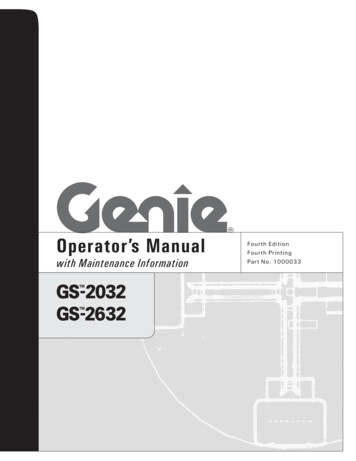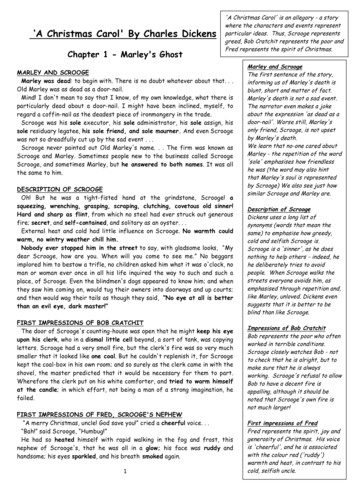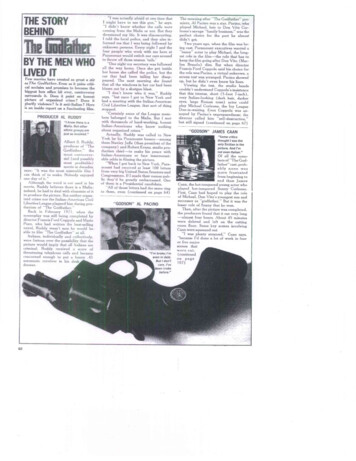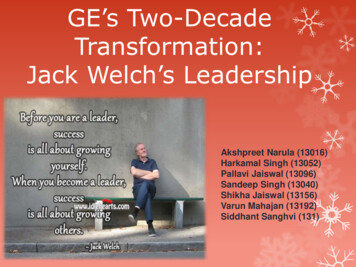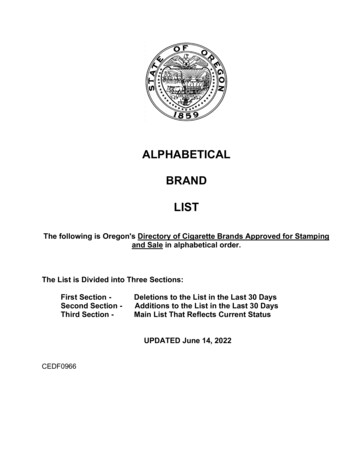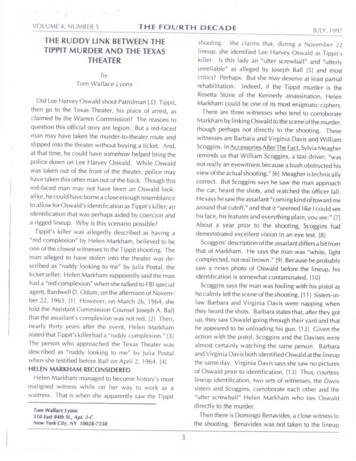
Transcription
VOLUME 4, NUMBER 5THE FOURTH DECADETHE RUDDY LINK BETWEEN THET1PPIT MURDER AND THE TEXASTHEATERJULY, 1997shooting. She claims that, during a November 22lineup, she identified Lee Harvey Oswald as Tippit'skiller. Is this lady an "utter screwball" and "utterlyunreliable" as alleged by Joseph Ball [5] and mostbyTom Wallace Lyonscritics? Perhaps. But she may deserve at least partialrehabilitation. Indeed, if the Tippit murder is theRosetta Stone of the Kennedy assassination, HelenMarkham could be one of its most enigmatic ciphers.Did Lee Harvey Oswald shoot Patrolman J.D. Tippit,then go to the Texas Theater, his place of arrest, asclaimed by the Warren Commission? The reasons toThere are three witnesses who tend to corroborateMarkham by linking Oswald to the scene of the murder,question this official story are legion. But a red-facedman may have taken the murder-to-theater route andthough perhaps not directly to the shooting. Thesewitnesses are Barbara and Virginia Davis and Williamslipped into the theater without buying a ticket. And,at that time, he could have somehow helped bring theScoggins. In Accessories After The Fact, Sylvia Meagherreminds us that William Scoggins, a taxi driver, "wasnot really an eyewitness because a bush obstructed hispolice down on Lee Harvey Oswald. While Oswaldwas taken out of the front of the theater, police mayview of the actual shooting." [6] Meagher is technicallycorrect. But Scoggins says he saw the man approachthe car, heard the shots, and watched the officer fall.have taken this other man out of the back. Though thisred-faced man may not have been an Oswald lookalike, he could have borne a close enough resemblanceHe says he saw the assailant "coming kind of toward mearound that cutoff," and that it "seemed like I could seeto allow for Oswald's identification as Tippit's killer; anidentification that was perhaps aided by coercion anda rigged lineup. Why is this scenario possible?his face, his features and everything plain, you see." [71About a year prior to the shooting, Scoggins haddemonstrated excellent vision in an eye test. [8)Tippit's killer was allegedly described as having a"red complexion" by Helen Markham, believed to beScoggins' description of the assailant differs a bit fromthat of Markham. He says the man was "white, lightone of the closest witnesses to the Tippit shooting. Theman alleged to have stolen into the theater was described as "ruddy looking to me" by Julia Postal, theticket seller. Helen Markham supposedly said the manhad a "red complexion" when she talked to FBI specialcomplected, not real brown." 191 Because he probablysaw a news photo of Oswald before the lineup, hisidentification is somewhat contaminated. [10]Scoggins says the man was fooling with his pistol ashe calmly left the scene of the shooting. [11] Sisters-in-agent, Bardwell D. Odum, on the afternoon of November 22, 1963. [11 However, on March 26, 1964, shetold the Assistant Commission Counsel Joseph A. Balllaw Barbara and Virginia Davis were napping whenthey heard the shots. Barbara states that, after they gotthat the assailant's complexion was not red. [21 Then,nearly thirty years after the event, Helen Markhamup, they saw Oswald going through their yard and thathe appeared to be unloading his gun. [12] Given theaction with the pistol, Scoggins and the Davises werestated that Tippit's killer had a "ruddy complex ion." 131The person who approached the Texas Theater wasdescribed as "ruddy looking to me" by Julia Postalwhen she testified before Ball on April 2, 1964. 141almost certainly watching the same person. Barbaraand Virginia Davis both identified Oswald at the lineupHELEN MARKHAM RECONSIDEREDthe same day. Virginia Davis says she saw no picturesof Oswald prior to identification. [13] Thus, courtesyHelen Markham managed to become history's mostmaligned witness while on her way to work as awaitress. That is when she apparently saw the Tippitlineup identification, two sets of witnesses, the Davissisters and Scoggins, corroborate each other and the"utter screwball" Helen Markham who ties Oswalddirectly to the murder.Then there is Domingo Benavides, a close witness toTom Wallace Lyons5 10 East 84th St., Apt. 3-CNew York City, NY 10028-7338the shooting. Benavides was not taken to the lineup3
VOLUME 4, NUMBER 5THE FOURTH DECADEJULY, 1997his suggestion that she might have misidentified Oswaldbecause she was terribly frightened. Markham tellsLane she had to be sure; that she had "them turn him."because he did not think he could identify Tippit'sassailant. However, he told Assistant CommissionCounsel David W. Belin that television and newspaperpictures "resembled the guy" (Tippit's killer). [14] In-[22]Mark Lane and Sylvia Meagher also challengeMarkham's claim that she was alone with Tippit for"About 20 minutes" and that the patrolman tried to talkto her even though he is believed to have died instantly.[23] Markham was absolutely terrified by her experience. Fear may have magnified her time estimate. Asterestingly, Benavides appears to provide partial corroboration to the Markham-Postal statements about theassailant's complexion. Ina slightly mangled colloquy,Benavides says the suspect's "skin looked a bit RUDDIER than mine" (my emphasis). [151 This is interestingsince Benavides is of Latin extraction.All witness credibility, including Markham's, wasregards Tippit's effort to speak, she tells Lane on thetape, "Yes sir, he tried to talk to me. He could not talk,get it plain enough for me to see, you know to hearhim." Markham claims that Tippit knew of her presence, that she last saw him alive when they put him intothe ambulance, [24] "which reached Tippit within nomore than five minutes of the shooting." [25] MaybeTippit did try to speak during a brief final moment.Perhaps Markham was fooled by an attempt to breatheor by neuro-muscular spasms. We will probably neverknow, a fact due in part to lingering uncertainty aboutcompromised by a lineup rightly assailed by critics whoshow that Oswald was made to stand out like a sorethumb. Perhaps the lineup was a product of policeineptitude; perhaps a conspiracy-driven attempt atwitness manipulation. Either way it is hard to imaginethat Oswald would have been fingered had Tippit'skiller not borne at least some resemblance to him.Admittedly, Oswald did not closely resemble theman whom Helen Markham described to BardwellOdum. Odum writes that Markham described Tippit'skiller as a "white male, about 18, black hair, redcomplexion, wearing black shoes, tan jacket, and darktrousers." [161 Granted this description is a bit offtarget. So probably is most description. That is why wethe officer's head trauma. [26]Sylvia Meagher delivers another punch when shesays of Markham, "she was in hysterics and somehowmanaged to leave her shoes on top of Tippit's car (CE1974)." [27] Meagher fails to give Markham's explanation. Markham states that Patrolman Tippit was bleed-have sketch artists.On the suject of recognition, Mark Lane rightlysavages Joseph Ball's leading cross examination ofHelen Markham who claims at first not to have "recognized" anyone in the lineup. [17] Ball asks Markham,"Was there a number #2 man in there?" Markhamresponds that the number #2 man gave her the chills.Mark Lane terms this a "mystical identification atbest." Sylvia Meagher states that she got "a few coldchills" from reading about this "identification" (quota-ing profusely, then says, "I had my workshoes in myhand. I laid them up on the squad car." 1281 Apparentlythe Lady was protecting her shoes.Helen Markham is consistent about the red face overthe nearly three decades which transpire between herinterview with Odum and the filmed interview with A& E. In the interim, during her testimony before Ball,she is inconsistent. She not only denies she told Odumtion marks are Meagher's). [18] But Lane and Meagherfail to mention that Markham remained uncertain of theidentification until she had the man turned sidewaysand back around. 119] It wasn't just chills. InterestinglyMarkham discussed the lineup identification with MarkLane in a phone-taped interview some three weeksprior to her Warren Commission appearance. [201 Inthat Tippit's killer had a red face. She also denies thatshe saw the black shoes indicated in Odum's notes.And she says she believes she described the killer asyoung, but not eighteen, the age written down byOdum. 129] In the A & E interview, the killer's "tanjacket" (Odum) becomes a brown jacket, and the "darktrousers" (Odum) become light grey. [30) Given herthe taped interview, her discussion of her identificationof Oswald is more clear and to the point. [21] Lanedoes not mention that the Dallas waitress clearly refutesnear consistency overtime, what explains her inconsistency before the commission? Was her commissiontestimony altered?4
VOLUME 4, NUMBER 5THE FOURTH DECADEJULY, 1997Under this scenario, falsely transcribed statementsaboutthe killer's shoes, face and age create an apparentsome doubts about this; 136; doubts worthy of consideration because of initial allegations that Tippit wasbroad spectrum repudiation of Odum's notes. Thepurpose? Maybe to camouflage the important item (thedispatched with an automatic weapon. Also, prior toOswald's arrest, a police officer radioed in his findingred face) by repudiating two items that are not important (the shoes and Oswald's age); or perhaps to camouflage the age, 18, six years younger than Oswald.of what was apparently an automatic cartridge case.1371After leaving the Beckley Street rooming house,Oswald encounters Tippit and shoots him. The taxidriver, William Scoggins, says he trotted casually awayInvestigators comparing Odum's notes and Commission testimony could hardly be blamed for findingMarkham hopelessly inconsistent.from the scene; that he muttered something like "poordamn" cop or "poor dumb" cop. [381Though other witnesses track his flight, the WarrenOswald manages to elude everyone until he turns up onThe suggestion that Markham's testimony may havebeen altered would not be justified were there notprecedent. There are at least four assassination witnesses who apparently had their statements to Com-Jefferson Boulevard; the location of the Texas Theaterand a shoe store run by Johnny Calvin Brewer. Brewermission and other investigators misrepresented. Theyare S.M. Holland 1311, Julia Ann Mercer [321, Rogerhears sirens. He sees police cars. He has heard on atransistor radio about the Kennedy shooting and theCraig [331, and Carolyn Arnold. [341STRANGE DOINGS AT THE TEXAS THEATERshooting of a police officer in Oak Cliff, his area ofwork. Then the Warren-Oswald appears in his win-The generally unhurried post-assassination behaviorattributed to Oswald is so inconsistent with his guilt anddow. Let us now enumerate the means by which theunhurried cop killer attracts the police.with his alleged antics at the Texas Theater that onemust ask: Could the same man have engaged in such1. Oswald gets Brewer's attention by looking into thecontradictory behavior in so short a time? A briefdescription of the Warren-Oswald's (Oswald according to the Warren Commission) post-assassination conduct will be followed by an examination of the circum-shoe store. Brewer's Oswald is "light complexioned,"perhaps a different hew from the "ruddy looking to me"stances that lead to his arrest.Critics have amply demonstrated that, if guilty, Oswaldup and looked like he had been running, and he lookedperson described by Julia Postal. His shirt tail is out.And he "just seemed funny. His hair was sort of messedscared, and he looked funny." Has the casual assassinsuddenly lost his cool? Also, Brewer believes herecognizes the man as having been a customer; he iswas, in Fifties vernacular, the acme of cool. Right afterthe assassination, he is seen in the TSBD lunchroom,apparently sipping a coke. Momentarily a suspect, hesure he has seen him "some place before." After thepolice cars depart, "Oswald" looks over his shoulder,confronts a gun leveled on him by a police officer. Hetakes this in stride. Unhurriedly, he leaves TSBD,then leaves and goes toward the Texas Theater. [391This journey also takes Oswald back TOWARD THEboards a bus, then hails a taxi which he offers to anelderly lady. He is dropped near his rooming house toSCENE OF THE SHOOTING. Writes Joachim Joesten,which he goes by foot. There he is seen by thehousekeeper Earlene Roberts."OSWALD PASSED THE THEATER, THEN RETRACEDApparently now in "quite a hurry," Oswald enters hisroom, then rushes out with his jacket and probably hispistol. 1351 Strange priority to delay an escape to fetchhe slip in the theater as he passed by?" And, asksJoesten, how did Oswald elude his pursuers and findthe leisure to attract Brewer's attention? [401a jacket! And one critic astutely noted that Oswaldwould have been insane to have retrieved his pistol2. Oswald's arrest is not brought about by theassassination of President Kennedy; not by the shootingafter the assassination since he might have needed it forof a cop. It results from the third and final misdeedattributed to him on November 22, 1963; his surrepti-HIS STEPS. If he was ducking a hot pursuit, why didn'this escape. Oswald was not insane. And he may nothave retrieved his pistol. Author Joachim Joesten raisestious entry into the Texas Theater. Innocence on this.5
VOLUME 4, NUMBER 5THE FOURTH DECADEcount alone would prove that Oswald was the patsy heclaimed to be. [41]Brewer says he stepped out of the shoe store andtracked Oswald as the latter made his way into theTexas Theater; that he actually saw him enter. [42]Since Oswald is relieved of 13.87 in cash after hisarrest, [43] there is only one apparent explanation forfailure to purchase a ticket. He does not want JuliaPostal to notice him; rather odd given his shoe storeantics. And not too smart. Oswald is likely, though notcertain, to be caught by Warren "Butch" Burroughswho tends the candy counter and takes tickets on weekdays. [44]There are more contradictions. Joesten tells us thatthe shoe store is "half a block WEST of the theater." [45]But Postal tells us about an Oswald, panicked by sirens,who appears "flying around the corner"; "coming fromEAST GOING WEST." [46] The Postal-Oswald seemsto move TOWARD the shoe store, not AWAY from it asdoes the Brewer-Oswald.Brewer says he would have noticed had Oswaldpurchased a ticket because he had a clear view of theticket booth. But Brewer also says he walked up to thebox office and asked Julia Postal if she had just sold aticket to a man in a brown shirt. Asked why he posedthis question, given his visual fix, Brewer responds, "Idon't know." [47]Postal says she didn't see Oswald sneak into thetheater, "because I stepped out of the box office andwent up to the front and was facing west. I was right atthe box office facing west—." Does she remain right bythe box office, or has she stepped away from it? And,given his panic, one might be surprised that Oswaldescapes Postal's attention long enough for surreptitiousentry. Whatever the case, Postal and Brewer decidethat Oswald has ducked into the theater. Brewer goesin to check. Postal calls the police and describesOswald as "ruddy looking to me." [48]The above contradictions might be written off todescriptive and perceptual fallibility were it not forinformation developed by Leo Sauvage, Jim Marrs andJ. Harris. 149] Leo Sauvage asked Dallas AssistantDistrict Attorney Jim Bowie whether a telephone callhad led to Oswald's arrest. Bowie told him there wasa call from the cashier, but also that there were "Half aJULY, 1997dozen calls!" Bowie also told Sauvage he didn't knowwhether Oswald had purchased a ticket, that Postalwas "too upset to remember." Subsequently Sauvageasked Julia Postal several questions, including the oneabout a ticket purchase. To all questions, Postal'sresponse was "no comment." She was smiling widely.Asked whether she had been told to respond this way,she said, "no corn—I mean, it's my own decision." [50]In Crossfire and conversations with me, Marrs discussed a taped interview [51] with Butch Burroughs.Marrs states that Butch Burroughs (the ticket-candyman) told him that somebody indeed stole into theTexas Theater at about 1:35 p.m.; that he went andchecked when he saw the double door to the theateropen. Burroughs also checked the balcony to whichthe person had obviously ascended. He did not findhim.But this person was not Oswald. Marrs writes thatBurroughs told him that Oswald purchased a ticket andeven bought some popcorn; that he entered the theatershortly after 1 p.m., prior to the Tippit shooting. Marrscorroborates Burroughs on this point through JackDavis, a theater patron, who told him that Oswald satnext to him minutes after the 1 p.m. beginning of thefilm.Also, Marrs says Burroughs told him Julia Postalknows she sold Oswald a ticket. Due to intimidation,she has left Dallas to live in another city. If Marrs iscorrect, the man who stole into the theater may haveprecipitated the arrest by deliberately attracting Brewer'sattention while Oswald was enjoying his popcorn.Marrs referred me to J. Harris, a long time assassination investigator, who told me he interviewed JuliaPostal. This interview took place in the office of theTexas Theater manager, Postal told Harris she thoughtshe had glimpsed a surreptitious entry out of the cornerof her eye. Eventually Harris turned the discussion tothe moment the police brought Oswald out of the TexasTheater. Harris asked Postal whether, upon seeingOswald, she had had any sense that she had sold hima ticket. Postal immediately burst into tears. Harriswalked out of the office, then reinterviewed Postal in anattempt to calm her with less troubling questions. Butshe burst into tears again when asked whether shemight have sold Oswald a ticket.
VOLUME 4, NUMBER 5THE FOURTH DECADESo-what do we know? We know that Tippit was shotOswald may have had a red race. Describing thechanges in his brother upon his return from Russia,though not necessarily by Oswald. We know thatOswald was subsequently arrested at the Texas Theater. We also know that somebody did something toinstigate calls to the police. Was this somebody a ruddyor red complected person seen by Julia Postal andHelen Markham? While this question cannot he an-Robert Oswald says, "—he had always been veryfair complected—his complexion was ratherRUDDY at this time—you might say it appearedlike an artificial suntan that you get out of a bottle,but very slight,—in other words, a tint of brown toswered, several possibilities should be considered.WHO WAS MR. RED?a tint of yellow." (55) (Italics mine) We don't know,of course, whether Oswald retained this colorationuntil the assassination.1. A RED HERRING: Ruddy looking and red complexion are vague; perhaps too vague to be takenseriously. Maybe Helen Markham is simply inconsistent. Also, Brewer and Scoggins did not ascribe3AN OSWALD LOOK-A-LIKE: In Crossfire, JimMarrs tells us about Bernard J. Haire who sawpolice bring a man he thought to be Oswald out ofthe BACK of the Texas Theater. Oswald was takena red face to "Oswald." Finally, if her sense ofdirection is accurate, Postal's "ruddy looking toout through the front. The Haire-Oswald was putinto a police car and driven away. Not quotingHaire directly, Marrs writes that Haire said the manme" person was going in the opposite directionfrom Brewer's subject. Postal and Brewer may2.JULY, 1997have been talking about different men.LEE HARVEY OSWALD. Dropped near his board-was "dressed in a pullover shirt and slacks andappeared to be FLUSHED as if HAVING BEEN in aing house by the taxi driver William Whaley,Oswald, according to critics, couldn't make it toTenth and Patton by the time of the Tippit murder.struggle." [56] (emphasis mine). Or maybe he hada red complexion.Marrs tells us Haire believed for almost twenty fiveSo much for the Whaley-Oswald. But there is theCraig-Oswald seen by Deputy Sheriff Roger Craig.years that he had witnessed Oswald's arrest. Marrsalso notes that the Tippit homicide report states thatWhen he saw Oswald in Dallas Police Captain J.W.Oswald was arrested in the balcony when in fact hisFritz's office soon after the latter's arrest, Craigidentified him as the man in Dealey Plaza whom hearrest took place on the main floor. Interestingly,Haire was unable to discern whether this man washad seen get into what was apparently a Ramblerstation wagon shortly after the assassination. 1521And what about the Click-Oswald? Dallas CountyAttorney Henry Wade claimed that a taxi driverhandcuffed. [57] Could this be the man alleged byButch Burroughs to have stolen up to the balcony;the "ruddy looking to me" person seen by JuliaPostal? Could the pullover shirt, mentioned bynamed Daryl Click had picked Oswald up. But,according to Mark Lane, there was no Dallas taxiHaire, be the brown sports shirt with the shirt tailout described by Brewer and Postal? (581 If not, wedriver named Daryl Click. (531 Unresolved, theClick enigma forces us to consider a third mode ofhave the possibility of three Oswalds haunting theTexas Theater:transportation for Oswald; two different taxis(Whaley-Click) and a Rambler station wagon (Craig).Finally there was T.F. White, an auto mechanic,1. The Warren-Oswald brought out the front.2. The Brewer-Oswald of shoe store notoriety.3. The Haire-Oswald escorted out the back ofwho claims he saw Oswald in a 1961 Ford Falconaround the time of and near the site of the Tippitshooting. The Falcon was parked close to theintersection where Whaley supposedly droppedthe theater.Note: The Brewer and Haire-Oswald is without the jacket described by Markham to Bardwel IOswald. [54]Odum. An abandoned jacket was found nearthe scene of the shooting. But it may not havebelonged to the murderer. 1591Bottom line: Prior to his arrest, any temporalgeographical fix on Oswald is problematical. And7
VOLUME 4, NUMBER 5THE FOURTH DECADEJULY, 19974. THE RED COMPLEXIONED MAN DESCRIBED BYHELEN MARKHAM TO BARDWELL ODUM: Thisafter looking "very carefully" at the suspects. [65] Fritzappears to get corroboration from Dallas Police Chiefman may not differ significantly in appearanceJesse Curry who tells Commission General Counsel J.Lee Rankin that he heard Markham identify the suspectfrom the above mentioned Oswald look-alike. Thereare two intersecting issues of degree: The degree ofto Fritz. [66]But Curry also says of Markham, "she didn't identifyOswald at that time," meaning the lineup. [67) Thisactual resemblance and the degree to which manipulation, persuasion and/or coercion parlayedthis resemblance into identification.While I have no reason to think Helen Markham wascoerced, I do believe the possibility should be considered. Why? Witness coercion has been well docu-statement is made to Commission member Gerald R.Ford. Failure to call Curry on his apparent contradiction may stem from his being questioned by twodifferent people. Still the statement leaves some doubtabout what actually happened. And, given BarnardHaire's experience, a mistaken identity must be consid-mented. Julia Postal has been mentioned as a possiblevictim. Others touched by threats or violence areAquitla Clemons, Warren Reynolds and DomingoBenavides. Domingo received threats after the murderered.Notes1. Report by Bardwell D. Odum, Federal Bureau ofof his brother, Eddy, who resembled him.What about the witnesses who corroborate HelenMarkham? I have no reason to believe the taxi driverInvestigation - FD-302. (Rev., 3-3-59) - DL 89-43;11/23/63.2. Warren Commission Hearings (WCH), Vol. III, p.William Scoggins was intimidated. Like Scoggins,Barbara and Virginia Davis seem to receive scantmention by Warren critics, perhaps because they corroborate Helen Markham. But Barbara Davis may havetold reporters that she only got a rear view of Oswald.1601 This would raise questions about her lineupidentification. Later she told Commission Counsel Ballthat Oswald "looked at me and then smiled-" 161]320.A&EHome Video, Cat. No. #AAE-21204, Copy3.right, 1989: 1992 Central Television Enterprises;Arts & Entertainment Network, HEARST/ABCN BC.4. WCH, Vol. VII, p. 11.5. Conspiracy, Anthony S ummers, McGraw Hill, 1980,p. 117.6. Accessories After the Fact, Sylvia Meagher, BobbsMerrill Company, Inc., 1967, p. 256.7. WCH, Vol. III, p. 327.8. WCH, Vol. III, p. 336.9. WCH, Vol. III, p. 333.Can this apparent contradiction be explained by unknown pressures that caused these women to quicklymove from Dallas to Athens, Texas?Virginia Davis moved "about two weeks" after theassassination. 1621 Barbara's departure time is unspecified. But it predates her March 26, 1964 Commission testimony. At the end of Barbara's hearing, Commission member Allen W. Dulles says, "You had movedfrom the house where these incidents took place."When Barbara answers affirmatively, discussion goesoff the record. Her testimony ends. 1631 This move offthe record must arouse suspicion for two reasons. One10. WCH, Vol. III, p. 334.11. WCH, Vol. Ili, p. 327.12. WCH, Vol. III, p. 343.13. WCH, Vol. VI, p. 461.14. WCH, Vol. VI, p. 452.15. WCH, Vol. VI, p. 451.16. Report by Bardwell D. Odum, FBI, FD-302 (Rev., 33-59); Nov. 23, 1963.RushTo ludgment, Mark Lane, Holt, Rinehart &17.is Barbara's possibly contradictory statements aboutwhether she saw Oswald's face. The other is the knownpattern of witness intimidation.Was Helen Markham's lineup identification of Oswaldtruly free of persuasion? lames P. Hasty Jr. claims thatWinston, 1966, pp. 179-80,18. Accessories After the Fact, p. 256.19. WCH, Vol. III, p. 311.he saw Markham "positively" identify Oswald. [64]According to Captain Fritz, Markham identified Oswald20. Rush To Judgment, p. 180.21. Markham Exhibit #1; WCH Volume XX, pp. 5868
VOLUME 4, NUMBER 5THE FOURTH DECADE88.Markham22.Exhibit #1; WCH Volume XX, p. 588.23. Rush To Judgment, p. 186; Accessories After theJULY, 199745. Joesten, Oswald: Assassin or Fallguy, p. 116.46. WCH, Vol. VII, pp. 10-11, 14.47. WCH, Vol. VII, pp. 4,5.48. WCH, Vol. VII, p. 11.49. I talked to "J. Harris" by phone. He said he did notFact, p. 256.24. WCH Vol. XX, pp. 583-4.25. Reasonable Doubt, Henry Hurt, Holt, Rinehart &Winston, 1985, p. 148.26. See "The Death of Officer J.D. Tippit: Was TippitShot Once or Twice in the Head?" by Frank J. SarnaIII, The Fourth Decade, Vol. 3 #5, July 1996, pp. 182127. Accessories After the Fact, p. 256.28. WCH, Vol. III, p. 317.want to give out his first name but thatthe first initialwould be sufficient for assassination investigators.Harris would not allow me to tape his statements.Nor did he furnish me with tapes or interview notes.Even though I have no written or taped evidence ofhis work, I use his statements as a supplement toinformation that Leo Sauvage developed aboutJulia Postal.29. WCH, Vol. ill, p. 317; Also report by Bardweil D.Odum, FBI, FD (3-2-2-59), Nov. 23, 1963.30. A & E Home Video, Cat. No. #AAE-21204, Copyright, 1989, 1992 Central Television Enterprises;Arts & Entertainment Network, HEARST/ABCNBC.31. Six Seconds in Dallas, Josiah Thompson, 1967,Bernard Geis Associates, pp. 82-3, 112.32. On the Trail of the Assassins by Jim Garrison,Sheridan Square Press, 1988, pp. 216-218. Also,Reasonable Doubt by Henry Hurt, Holt, Rinehart &Winston, 1985, pp. 113-16. Readers should notethat Mercer places Oswald alongside Ruby in Reasonable Doubt. This Oswald connection is apparently omitted by Garrison in On the Trail of theAssassins.33. Forgive My Grief, Vol. III, Penn Jones Jr., Library ofCongress Catalog Card Number: 66-22345, pp. 335.34. Summers, Conspiracy, pp. 107-8.35. Warren Commission Report, WCR, pp. 6, 653-4.36. Oswald: Assassin or Fallguy, Joachim Joesten,Marzani & Munsell Publishers, Inc., pp. 104-5.37. Hurt, Reasonable Doubt, pp. 155-56. Also, for50. The Oswald Affair by Leo Sauvage, The WorldPublishing Company, Cleveland, Ohio, 1966, pp.100-101.51. Most of the information in this and the next twoparagraphs comes from Jim Marrs' book Crossfire,Carroll & Graf Publishers, Inc., New York, 1989, p.353. But Marrs gave me some supplementaryinformation during a talk at the 1994 COPA conference and during a phone talk in October, 1996.Statements attributed to Burroughs about Julia Postalare not in the book.52. WCH, Vol. XIX, CE #5323, p. 524,53. WCH, Vol. II, pp. 49-50.54. "Tenth and Patton" by William Weston, pp. 29-30,The Fourth Decade, Vol. 4 #1, November, 1996.55. WCH, Vol. I, p. 330.56. Marrs, Crossfire, p. 354.57. Marrs, Crossfire, p. 354.58. WCH, Vol. VII, pp. 3,14.59. See Meagher, Accessories After the Fact, pp. 27480.60. Sauvage, The Oswald Affair, p. 78.61. WCH, Voi. III, p. 344.further questions about the correlation betweenOswald's pistol, the ammunition, see pp. 152-55.38. WCH, Vol. III, p. 327.39. WCH, Vol. VII, pp. 2-4.40. loesten, Oswald: Assassin or Fallguy, p. 116.41. WCH, Vol. XX, Kantor Exhibit No. 3, p. 366.42. WCH, Vol. VII, p. 4.43. Warren Commission Report, p. 745.44. WCH, Vol. VII, pp. 9, 13, 14-17.62. WCH, Vol. VI, p. 455.63. WCH, Vol. III, p. 350.64. Assignment Oswald by James P. Hosty, Jr., ArcadePublishing, Inc., New York (Dist. by Little Brownand Company), copyright, 1996, p. 26.65. WCH, Vol. IV, p. 212.66. WCH, Vol. IV, p. 176.67. WCH, Vol, IV, p. 175.9
THE FOURTH DECADEVOLUME 4, NUMBER 5A LEAGUE OF THEIR OWN: A LOOKINSIDE THE CHRISTIAN DEFENSELEAGUEJULY, 1997League (CDL), which had been in 'limbo' these pastyears." [6] In early 1964 the CDL was officiallyincorporated with Richard G. Butler as President; attorney Bertrand L. Comparet, Vice President; Steve Foote,Western Regional Director; and Rear Admiral, USN(Ret) John G. Crommelin, Eastern Regional Director.byD. BoylanThe heating up of the Cold War, the Supreme Court's[7]Swift began as a "Ku Klux Klan organizer and Klandecision to end segregation in 1954, and the establishment of a Communist Cuba in 1959 led to an unparalleled growth of extremist organizations from the Johnrifle-team instructor." [8] In 1946, Swift formed theChurch
Fear may have magnified her time estimate. As regards Tippit's effort to speak, she tells Lane on the . Sylvia Meagher delivers another punch when she says of Markham, "she was in hysterics and somehow . Helen Markham is consistent about the red face over the nearly three decades which transpire between her




